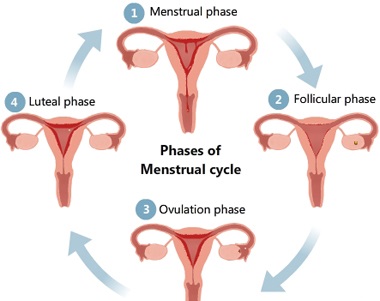Your menstrual cycle is the best indicator for the health of your reproductive system. Although you may have some inconvenience or pain during your period, the knowledge you gain from it is extremely helpful. When you are planning a pregnancy, conceiving in the future, or simply want to be more conscious about the health of your body, your menstrual cycle phases will give you the information that you need.
Menstrual Cycle Phases
Your menstrual cycle begins when blood begins to come out of your vagina; this is day one of your cycle. Most menstrual cycles are 28 days, therefore the menstrual cycle phases are based on a 28-day cycle. There are four main phases during your cycle:
- Day 1 – 5: Menstrual Phase
- Day 1 – 13: Follicular Phase
- Day 14: Ovulation Phase
- Day 15 – 28: Luteal Phase


1. Day 1 – 5: Menstrual Phase
This phase starts the day you begin to bleed and ends on the fifth day of your cycle. During this phase, the soft tissue and blood vessels that make up the inner lining of your uterus are shed through your vagina in the form of menstrual blood.
On average you will lose about 10 ml to 80 ml of blood during this phase. The release of the lining may cause abdominal cramping as your uterus contracts to expel the fluid.
Tips for this phase: Avoid activities such as dating or socializing. You may want to try a hot Epsom salt bath for relief. Also control the intensity of your exercises to gentle movements such as walking or yoga.
2. Day 1 – 13: Follicular Phase
This phase also starts on the day you begin to bleed; however, this phase focuses on follicle development in the ovaries. When this phase begins, your uterus is thickly lined with nutrients and fluids meant to nourish the embryo. When there is not an egg to be fertilized, the estrogen and progesterone levels are low causing the uterus to shed its lining.
At this time, a follicle-stimulating hormone is created by the pituitary gland which causes anywhere from 3-30 follicles to grow. These follicles each contain an egg, and eventually begin to breakdown while one (the dominant follicle) remains. The dominant follicle produces estrogen which causes the uterus to begin preparations for the egg and increases the luteinizing hormone.
At the end of this phase, the egg is released. (This is known as ovulation.)This phase is the most variable in length among all menstrual cycle phases and may last for 13-14 days.
Tips for this phase: This phase is a great time to solve problems, brainstorm new projects, or make big decisions. Strenuous exercise will also feel extremely good at this time.
3. Day 14: Ovulation Phase
This phase begins when the luteinizing hormone surges causing dominant follicle to bulge and rupture releasing the egg. It will usually last about 16 to 32 hours; it ends when the egg is released.
There is a 12-hour window where the egg can be fertilized after it is released. If you want to become pregnant, it is important that sperm is present in the reproductive system before the egg is released.
During this phase, you may feel a small pinch in your lower abdomen, on either side. The pain can last up to a few hours.
Tips for this phase: This is the best time for job interviews or public speaking. Your energy levels are extremely high during this phase, so it is a good time to get in a lot of physical activities or schedule a date night.
4. Day 15 – 28: Luteal Phase
Of all the 4 menstrual cycle phases, this is the last in your cycle. During this phase, the egg is located in the fallopian tube for about 24 hours. If it is not inseminated during this time, the egg cell actually disintegrates.
At this point, you have used up the hormone which causes the uterus to keep its endometrium. This hormone being depleted is what causes the beginning of your next cycle to begin.
Tips for this phase: It is important that you have good self-care habits in place during this phase. This is when you will notice the common symptoms of PMS. During this phase you should aim to eat healthier foods and spend more time alone. It is also a good habit to practice yoga, meditation, or other relaxation techniques during this phase.
